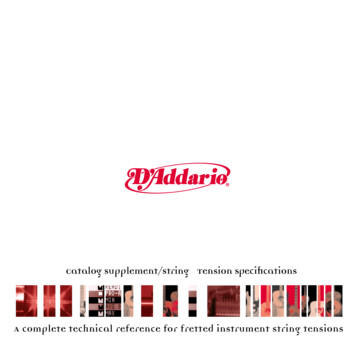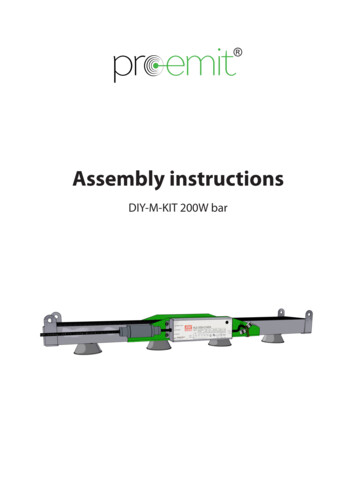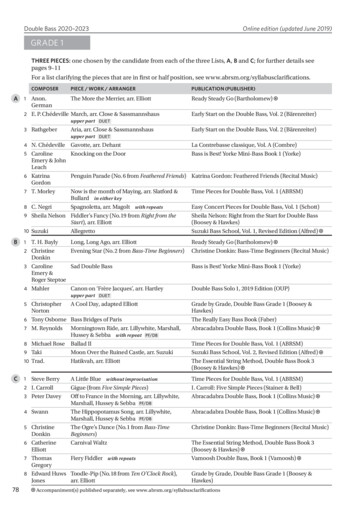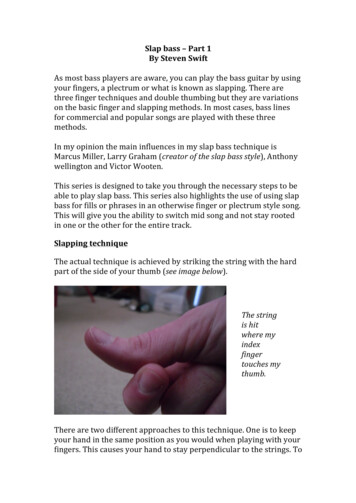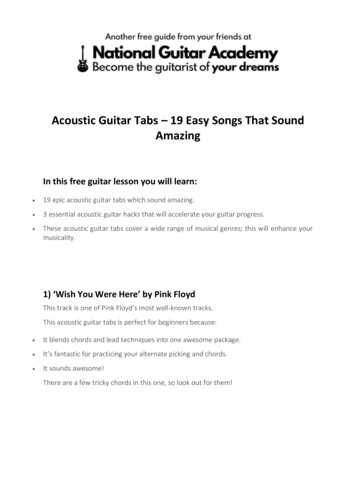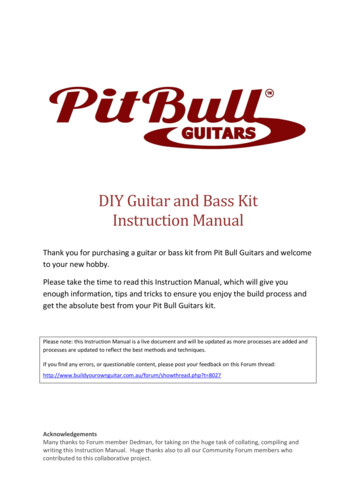
Transcription
DIY Guitar and Bass KitInstruction ManualThank you for purchasing a guitar or bass kit from Pit Bull Guitars and welcometo your new hobby.Please take the time to read this Instruction Manual, which will give youenough information, tips and tricks to ensure you enjoy the build process andget the absolute best from your Pit Bull Guitars kit.Please note: this Instruction Manual is a live document and will be updated as more processes are added andprocesses are updated to reflect the best methods and techniques.If you find any errors, or questionable content, please post your feedback on this Forum showthread.php?t 8027AcknowledgementsMany thanks to Forum member Dedman, for taking on the huge task of collating, compiling andwriting this Instruction Manual. Huge thanks also to all our Community Forum members whocontributed to this collaborative project.
DIY Guitar and Bass Kit Instruction ManualContentsIntroduction . 3My Build Diary . 3Before you Start . 4Now, before we go any further, some advice: . 5What tools do I need? . 5Nice tools to have, but not essential: . 6Really nice tools to have: . 6Building Your Pit Bull Guitars Kit . 7“Mock Build” and Fitting the Bridge and Neck . 7Test fit the parts. 7Fitting the Neck . 7Checking the Scale Length . 8Fitting the Bridge/Tailpiece . 9Test fitting the Neck. 11Checking neck alignment . 11Preparing the neck . 12Painting or Staining. . 17Preparation for finish . 17Painting . 20Staining . 21Polishing . 23Wiring and final Assembly . 23Shielding. 23Wiring. 24Final Assembly . 27Mounting pickups and pick guards . 28Installing the Bridge . 28Installing the Tuners . 29Attaching the neck . 30Final Assembly, Tuning and Intonation. 30Fitting the strings . 30Tuning and setting the intonation. . 302
DIY Guitar and Bass Kit Instruction ManualIntroductionPit Bull Guitars offers such a wide range of kits; often with multiple options, that we areunable to cover each and every model (and option) in “step-by-step” detail in one Manual.So, this Manual focusses on the general DIY Kit building processes which are common tomost of our kits.If you have specific issues during your build, we strongly urge you to join our CommunityForum.Please note: All general build support is provided by the Community Forum, we are unableto provide email or phone support for your build. This does not include warranty issues.My Build DiaryThe very first thing you should do, as soon as you receive your kit (or even before), is to startyour build diary in the My Build Diary forum and post your build progress.Simply register on our Community Forum and got to the My Build Diary Forum. Then simplyclick on, give your Build a Title and post any questions you have.Almost any build issue or modification will have been dealt with before by our experiencedForum members.Also, reading other members’ Build Diaries offers a gold mine of information, advice andideas for your own build.Got a question, just ask!Register on the Forum here: http://www.buildyourownguitar.com.au/forum/And introduce yourself rumdisplay.php?f 513
DIY Guitar and Bass Kit Instruction ManualBefore you StartFirst thing to know, these guitar kits are not “Ikea Guitars” that you simply paint andassemble; they are the raw product from the same factory that produces guitars for some ofthe world’s best-known brands. It is up to YOU to get the absolute best out of the kit youhave received.Yes, there may be the odd scratch or dent, or glue spot to deal with, but these should justsand out. You may even find small cracks or other imperfections, which can be filled with noeffect on the guitar’s tone. Any large cracks, especially at joins, should be reportedimmediately, so we can replace or refund your kit.OK, so the Postman has just left me a big box of bits what do I do now?Firstly, make sure everything is there. Our factory is very good at ensuring everything isincluded in your kit, down to the very last screws, but it always pays to check.If you think you are missing something, please double(triple)-check before contacting us.Make sure small parts aren’t caught up in the paper or foam packaging material makesure you check all the filler materials before recycling.Lay out the parts and ensure everything is there and nothing is broken.Photo by DedmanCheck that all parts are present. A good way to do this is to put all the parts loosely on thebody and neck.If you are not sure what a part is for, no problem. Take a quick photo of the part and post iton the General Support Forum.4
DIY Guitar and Bass Kit Instruction ManualNow, before we go any further, some advice:1. Work safe! Sharp tools, dust, glue and paints all have their own risks. Please readthe precautions on the packaging and be aware of your surroundings (heat, water,electricity).2. Measure twice, cut once. Make sure you mark, then measure again before cutting ordrilling anything.3. If you aren't sure about something.STOP. Get advice from the Forum. Postingpictures of your issue will make it much easier for members to give advice.4. “Sand, sand, and sand again. Then, when you think you have sanded enough, sandit some more.” – our Resident Luthier’s motto. Note: If your kit has a veneered top;such as Spalted, Flame, or Quilted Maple, do not sand the veneer. The veneer isless than a millimetre thick and is incredibly easy to sand through it.5. Don't rush! Mistakes usually occur when we aren't concentrating, the more time youput in the better the end result will be.6. Always lubricate screws before putting them in. Have a block of bees wax or soap onthe bench and just wipe the thread of the screw along the edge of the block. This willmake the screw easier to drive in and will stop it binding and being difficult to removein the future.7. Use quality screwdrivers, the 2 bargain ones will wreck the heads of your screwsmaking them ugly and hard to remove.8. Use a drill size slightly smaller than the screw. If you hold the drill over the shaft ofthe screw you should still be able to see the threads on both sides.9. Work clean. If you get glue or paint on your hands, stop work. Clean them. There isnothing worse than turning your master piece over and finding finger prints on theback.10. Enjoy yourself. If you are getting frustrated or tired, stop work, come back to it later.What tools do I need?You will need the following tools: File or fine raspSandpaper (180 grit to 2000 grit)Steel wool (0000 grade)Coping saw (only if your kits head stock came unshaped)Electric DrillDrill bits, 1mm, 1.5mm, 2mm, and 3mmG ClampsPit Bull Guitars Wood glue (for set neck kits)Screw drivers, both Phillips (sizes small 0 med 1 and large 2) and flat headLong straightedge (600mm rule) and tape measureSoldering ironElectronic solder (there is some included with your kit)Clean ragsPencilEye protection5
DIY Guitar and Bass Kit Instruction Manual Wire cuttersGuitar TunerNice tools to have, but not essential:Notched straight edge (available in the Pit Bull Guitars store)Fret crowning file (available in the Pit Bull Guitars Store)Random orbital sander (not the 1/3 sheet sanders, they leave circular scratches)12" Radius sanding block1" & 2" sanding drum (fit in the electric drill)Helping hands alligator clampsPortable clamping workbenchDigital callipersMulti-meterJigsawPhoto by Pit Bull GuitarsReally nice tools to have:Drill pressSet of nut filesDremel (or similar rotary tool) and bits for sanding and polishing.Air brush and compressor.Large workbench with a vice for holding small parts.6
DIY Guitar and Bass Kit Instruction ManualBuilding Your Pit Bull Guitars Kit“Mock Build” and Fitting the Bridge and NeckTest fit the partsNow that we know we have everything, we can do a “Mock build”; also known as Dry Buildor Test Fit.This is an important step, as it is now that we check that everything fits as it's supposed to.Now is also the time to make any adjustments for upgrades you have planned; such asdifferent tuners, bridges or pickups.It is far easier to make any adjustments or modifications before applying any finish. Fit the tuners, finger tight (no need to drill the fixing screw holes just yet).Test fit the pickups (again no need to drill the holes just yet, just make sure they fit inthe cavity).Place the pick guard in position and check for fit. Have a look at some of the finishedguitars on our Forum if you are not sure how the pickguard should be placed.If you are using aftermarket switches and volume/tone pots, you will probably find theholes are too small. The best tool to enlarge the holes is a reamer. If you don't haveone you can use an electric drill going in reverse at slow speed. This will help avoidany tear out. Alternatively, you could use a round file, or sandpaper wrapped arounda thin rod.Doing all the fitting and measuring now, before any finish is applied, is far easier and avoidsany slips or scuffs ruining your work. So, basically, we loosely assemble the guitar, then takeit apart again before applying our paint or stain.Fitting the NeckGently seat the neck heel in the pocket.Hopefully you have a nice tight fit in place, and maybe you even need to do some sanding toget the neck in place. Sand the neck pocket rather than the neck heel, using a sandingblock to keep things straight. Don't sand the floor of the neck pocket or the heel of the neck,there is a "break angle" incorporated into the routing that we don't want to modify as it setsthe string angle over the fret board.Lightly clamp the neck in place being sure to put some padding (cardboard or soft foam), ora wood block with fret grooves cut, between the clamps jaws and the frets and the undersideof the neck pocket. See following image:7
DIY Guitar and Bass Kit Instruction ManualPhoto by KickNeck clamped with wooden block, with grooves cut top protect the frets.Checking the Scale LengthNow comes some important measuring. Find the scale length for your instrument. Most PitBull Guitars 6 string guitar kits are either 25.5 inches (648mm) or 24.75 inches (628mm) andmost bass kits are 34 inches (864 mm). It should say in the Product Description what scalelength your kit is. If in doubt, please ask the Forum.If you measure from the inside (face) of the nut to the top of the 12th fret, then double thatmeasurement, you will have the scale length of your neck.The bridge needs to be situated so the saddles are at a position that allows them to beadjusted for setting the intonation later, so set the saddles to the middle of their adjustmentand check that it is approximately at the end of your scale length.Protip: you will hear a lot of guitarists say, “the distance from the inside of the nut tothe 12th fret should be the same as the 12th fret to bridge saddle distance”.It’s not quite that simple. You will see that on all guitars (electric and acoustic) thatthe bridge is on an angle. The reason for this is that the thicker strings (EAD), requiremore distance (from the 12th fret to the bridge saddles than the thinner strings (GBE).This compensates for the vibration characteristics of the thicker strings. See imagebelow:8
DIY Guitar and Bass Kit Instruction ManualNow might be a good time to sit back and watch our video on scale length, featuring GavinBramley for Bramley Guitars. Check it out here:https://www.youtube.com/watch?v YJTQLLnscgg&t 7sFitting the Bridge/TailpieceFitting the bridge/tailpiece/tremolo will depend on which kit you have.Tune-O-Matic style:Don't press in the threaded inserts yet. Insteadwrap either multiple layers of masking tape orsome plastic tubing around the posts and pushthem into the post holes in the body. We aren'tgoing for a precision fit, just something to holdthem in place while we do some measuring.Trapeze style bridges:Measure the guitar body width at various pointsand mark the centre line with a soft pencil. Do thison both sides, which will give you a centre line.Mark it onto the edge (side) of the body by joiningthe first two lines. Now, take the small plate partof the trapeze tailpiece and mark where it will go(the centre hole will be on the line). Mark all 3holes and then drill with a 2mm drill. Attach the2nd part of the trapeze tailpiece and lightly screwthe 3 screws in.If your guitar has the fixed style bridge (with thesaddles), wrap some tape or rubber tube aroundthe posts and slip them gently into the holes, don'tinstall the threaded bushings into the body yet.Bigsby Style tremolo:The same process applies for the Bigsby style tremlo,mark a centre line in the body and on the string bar of thetremlo, line them up, drill and lightly screw in place. Thebridge itself can be held in place as per the Tune-o-matic style.9
DIY Guitar and Bass Kit Instruction ManualFloyd Rose (Genuine or Licensed) Tremolo:The Floyd Rose tremolo balances on 2 posts; the holes forwhich are pre-drilled. For the point of this exercise (preparing to fitthe neck) it can simply sit in place in its cavity with a steel ruleunder the back to hold it up.Strat style tremolo:Much like the Floyd Rose except it has 6 fixingscrews across the front. At this stage, we don'tneed to drill them.Telecaster style bridge:Mark a centreline on the body and on the bridge and line them up.Make sure the saddles are in the middle of their movement range.The bridge is held in place by the screws at the back of thebridge, mark the positions when you have the centre of thesaddles at the end of your scale length. If you are using anaftermarket bridge pickup and possibly even the factory one youmay find that the cavity is too far back and needs to be opened upfor it to fit. If you have a router, it's a small job to open the cavity up a bit. If you don't (likemost of us), a sanding drum on a rotary (dremel) tool or cordless drill will also do the job. sowill good old sand paper and elbow grease. (aren't power tools wonderful?)Bass bridges:Most bass bridges can use the Telecaster instructions or the Tune-o-matic topinstructions.10
DIY Guitar and Bass Kit Instruction ManualTest fitting the NeckWith the neck lightly clamped in place and the tuners for both E strings in place, install those2 E strings (the thickest and thinnest). No need to tune them yet, just put enough tension onthem to be tight.Now check that the strings are running parallel to the neck with equal space between thesting and the edge of the fretboard, as in the following images.Photo by Dedman*note this clamp has soft jaws in place, if yours doesn't have them use a piece of cardboard, soft foam or wood(with fret grooves cut) to protect the frets and neck.Photo by MarcelSet (Glued) Neck clamped by the extended heel.Checking neck alignmentIf things don't line up, check you have the neck heel properly seated in the pocket. Somekits may have a bit of “wiggle room” in the pocket, so try moving the neck until you have thestrings correct aligned along the fretboard. In some cases, you may even need to do somevery careful sanding on the neck pocket until the string do correctly align.11
DIY Guitar and Bass Kit Instruction ManualAlso, while you are here, check the break angle of the neck the strings should clear thefrets but not by much. Remember, the bridge when installed properly will have string heightadjustment.If your kit has a bolt on neck, you can take a suitable size drill, check how deep the holesneed to be (you don't want to be drill through the fret board). Don’t forget to account for theneck plate thickness.Put some tape around the drill bit as a depth marker and drill the neck mounting holes.Don't install the neck yet, we have work to do on it yet!If your kit has a set (glued in) neck, you need to decide whether you glue the neck in now orafter sanding and finishing.It is much easier to work on the guitar while it's in 2 pieces. However, if you want aseamless join between neck and body, it's better to glue it before final finishing.You can, of course, fit it sometime in between. Much will depend on the type of finish youdecide on (ie, stain versus solid colour).Preparing the neckDepending on which kit you have, you may need to shape the headstock. Many of our kitscome with a “Paddle” headstock. This means the factory has left you a blank canvas toshape your own headstock.6 Inline “Paddle” Headstock3-a-side “Paddle” Headstock12
DIY Guitar and Bass Kit Instruction ManualIf you have a “Paddle” headstock, then the design is entirely up to you.You can design something completely original or use a Brand design; like a Fender orGibson style headstock1.A quick Google search will come up with plenty of PDF files you can print out and use as atemplate if you want a Brand shape.If you design your own, please remember the strings exert a lot of force on the headstock(especially basses), so leave plenty of wood around the tuner holes.Once you have decided on a design, make a card board template and trace it onto yourheadstock and cut it out. A jigsaw works well, as does a coping saw. Don't try to cut right onthe line, leave some space then file and sand back to the line making sure to keep the edgesparallel.Photo by DedmanUse a stiff cardboard template to trace your designPhoto by Pit Bull GuitarsCutting with a jigsaw1It is legal for you to shape your headstock in the style of Brand name guitars, for your own personal use.However, it is illegal if you put that Brand’s logo on the headstock and attempt to sell the guitar as a genuineBrand guitar.13
DIY Guitar and Bass Kit Instruction ManualCheck out our YouTube Video for shaping the headstock here:https://www.youtube.com/watch?v YPNvCnhUiYYNext step. We need to check if the neck has any bow in it. A notched straight edge is thequickest easiest way to do this.If the neck has a concave bow, then turning the truss rod nut to the right (clockwise) tightensthe rod and straightens the neck out (and if it is continued to be turned, will finally introduce aconvex bow).If your neck has a convex bow, then turning the truss rod nut to the left (anti-clockwise) willreduce the amount of bow, then hopefully straighten the neck and then introduce a concavebow.Protip: your kit should arrive with a slight convex bow. If this is the case, there is noneed to adjust the truss rod now; as when you attach the neck and install and tensionthe strings, this convex bow should flatten perfectly.Minor adjustments can be made once the strings are installed and tensioned.14
DIY Guitar and Bass Kit Instruction ManualUsing a Notched straight edgePhoto by DedmanPhoto by DedmanDon't be too critical on the neck bow just yet, as the string tension will change the curveonce it's all set up.For the next step, we need either a 12” radius sanding block or a large straight edge. Abuilder’s level, about 600mm (2ft), is also ideal.Mask up the fret board with tape, leaving the frets visible.Use a felt pen or Sharpie to draw a line on the top of each fret, then, with some fine (400)wet and dry sandpaper wrapped tightly around your straight edge make a few passes overthe frets. Any high frets will immediately lose their marking.15
DIY Guitar and Bass Kit Instruction ManualPhoto by Dedmanmarking frets with marker penPhoto by Dedmanlight sanding shows the high spotsCheck that the fret is properly seated. If it is clearly sitting a little high (proud), it can begiven a few taps with a plastic hammer or a small block of wood on the fret. Usually, a fewmore passes with the sandpaper and straight edge will see all the frets shiny and the markergone.Of course, now we have flattened the tops and need to recrown the frets.You can purchase a Fret Crowning File from our Shop, here, or crowning frets can be donewith patience and a small triangular file.Pay extra attention the ends of the frets. You can then finish polishing the frets with 000 steelwool or 2000 wet and dry paper. Do keep plenty of layers of masking tape over the fretboard during the process, so any slips don't end up as a gouged fretboard.If you don’t want to use masking tape, fretboard protectors and fret files are available fromthe Pitbull store, here.16
DIY Guitar and Bass Kit Instruction ManualTake your time and be patient. Time spent here will make the world of difference to howyour instrument plays.The final finish on the fret board will depend on what timber it is. Rosewood and Ebony areusually left bare and given a coat of lemon oil or Dingotone Guitar Wax.Maple boards can be given a clear coating of Dingotone (neck kit) or Tru Oil to seal them.For fretless basses, a couple of coats of super thin CA glue (supa glue), sanded with veryfine paper between coats will provide a hard smooth surface.Painting or Staining.Preparation for finishNow we must decide on how our finished guitar is going to look. Basically, there are 2choices, a solid painted colour or a stain, with either clear coats or some form of oiled finishover the top. Either will require a good foundation to give the best result, and that foundationis. sanding.Don't skimp on cheap sand paper, it's false economy as you will get much more use fromgood quality product as well as a better job.If your kit has a veneered top such as Spalted, Flame, or Quilted Maple, DO NOTSAND THE TOP! The veneer is less than a millimetre thick and it is incredibly easy to sandthrough it.If your kit has binding, it is best to mask it up with masking tape as deep sandpaperscratches will draw in stains or paints later and be difficult to clean up.Sandpaper grades given here are ISO/FEPA, as used in Australia and Europe. USA gradesdiffer, Wikipedia has a conversion chart.On solid body guitars start with 120p or 180p grit to remove the worst machining marks(basswood is soft and 180 is a good place to start).Always sand with the grain of the timber and use a sanding block to keep the paper flat onthe surface.You can use a random orbital sander at this stage. These are usually the circular pad type.Avoid the 1/3rd sheet rectangular sanders as they tend to leave circular scratches in thesurface that require even more sanding to get out.17
DIY Guitar and Bass Kit Instruction ManualAlways sand in the direction of the grain.Photo by DedmanSand in the direction of the grainThe edges and cutaways usually require the most sanding. Various diameter cardboardtubing or even aerosol cans are great for using as sanding blocks in cutaways. Do the edgesby hand to get a nice rounded feel.After the initial sanding it's time to check for glue marks or cracks. Small cracks or dents canbe filled with a wood filler matching your final finish.Glue spots (glue from the factory, usually in “spots”, left on the body or neck) are only aconcern if you are staining rather than using a solid colour. The best way to check for gluemarks left by the factory is to run over the body and neck with a damp rag (damp, not wet)glue will show up as whitish marks.You especially need to check for glue spots on veneered tops and kits with binding, stainswill not soak into or adhere to glue.On the back and sides of a solid body, glue spots can usually be sanded out and fillerapplied, if necessary.On veneers the best method found so far seems to be a product called "Goof Off". Applied tothe glue spots and rubbed until the glue is dissolved. Using a very small soft wire brush(tooth brush size) will also help, but be very, very careful on those thin veneers.Don't sand beyond 220 grit, as we need the surfaces to have some "tooth" for the finishes tostick to and sanding too fine will polish the wood and stop stains from penetrating evenly.18
DIY Guitar and Bass Kit Instruction ManualHolding the body for finishingPhoto by DedmanPhoto by DedmanA handy way of holding a body for painting or staining is a piece of timber attached in placeof the neck. (notice the tooth picks used to block screw holes)19
DIY Guitar and Bass Kit Instruction ManualPhoto by Dedmanor a dowel in the output jack hole.Mask any binding with masking tape (the plastic pin striping tape curves nicely and forms abetter seal on the edges). For hollow body guitars, stuff the body with crumpled paper toavoid drops landing inside the F holes.Also mask the neck cavity and heel on set (glue in) neck kits, as any paint or stain willprevent glue from penetrating. Advanced painting, such as bursts and paint effects, will becovered in future Forum tutorials.Check out our Sanding video here:https://www.youtube.com/watch?v NE40TZ38nmUPaintingPainting is probably the easiest finish to do, but getting that glassy, mirror-like finish you seeon Factory guitars. It is a skill that can take years to master ask any Auto Repairer.For painting, you can choose from enamels, auto acrylic or special nitrocellulose guitarfinishes; either in aerosols or requiring a compressor and spray gun.One thing they all have in common is that the top coat will only be as good as the onesunder it. You can get a good finish with a brush if you are prepared to do the prep work andsanding. We strongly recommend you buy the best brush available and keep it clean.A sanding/grain filler or a diluted slurry of filler like "Timbermate" will fill the grain of thetimber leaving a smooth base for your paints. Apply, then sand to 320 grit.20
DIY Guitar and Bass Kit Instruction ManualStart with the recommended primer for the paint you are using.Spray cans that say they don't need primer are generally made for use on steel, ask theretailer for suitable primer for wood.Put on a thin coat of primer and allow it to dry for at least 24 hours. Then, sand it back with320 grit sandpaper. Yup, you sanded through the primer, back to bare wood on the edgesand some other spots. That is good!Now, apply another coat of primer, doing the edges first, paint the body, then give the edgesanother coat. Allow to dry for another 24 hours, sand and repeat, then again and sand with400 grit paper.You should be able to sand it silky smooth now with no high spots and no grain showing.Allow to dry for several days, preferably a week before applying top coats.Top coats are a repeat of the priming process. The first coat mostly gets sanded off quicklyshowing any low or hi
DIY Guitar and Bass Kit Instruction Manual Thank you for purchasing a guitar or bass kit from Pit Bull Guitars and welcome to your new hobby. Please take the time to read this Instruction Manual, which will give you enough information, tips and tricks to ensure you enjoy the build process

